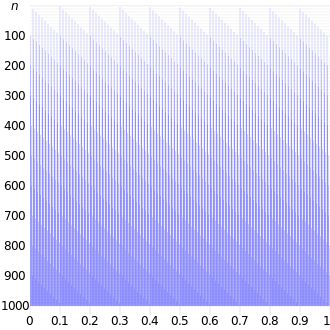Van der Corput sequence

Illustration of the filling of the unit interval (horizontal axis) using the first n terms of the decimal Van der Corput sequence, for n from 0 to 999 (vertical axis)
A van der Corput sequence is the simplest one dimensional low-discrepancy sequence over the unit interval first published in 1935 by the Dutch mathematician J. G. van der Corput. It is constructed by reversing the base n representation of the sequence of natural numbers (1, 2, 3, …). For example, the decimal van der Corput sequence begins:
- 0.1, 0.2, 0.3, 0.4, 0.5, 0.6, 0.7, 0.8, 0.9, 0.01, 0.11, 0.21, 0.31, 0.41, 0.51, 0.61, 0.71, 0.81, 0.91, 0.02, 0.12, 0.22, 0.32, …
whereas the binary van der Corput sequence can be written as:
- 0.12, 0.012, 0.112, 0.0012, 0.1012, 0.0112, 0.1112, 0.00012, 0.10012, 0.01012, 0.11012, 0.00112, 0.10112, 0.01112, 0.11112, …
or, equivalently, as:
The elements of the van der Corput sequence (in any base) form a dense set in the unit interval: for any real number in [0, 1] there exists a subsequence of the van der Corput sequence that converges towards that number. They are also equidistributed over the unit interval.
See also
- Bit-reversal permutation
- Constructions of low-discrepancy sequences
- Halton sequence, a natural generalization of the van der Corput sequence to higher dimensions
References
- van der Corput, J.G. (1935), "Verteilungsfunktionen. I. Mitt.", Proc. Akad. Wet. Amsterdam (in German) 38: 813–821, Zbl 0012.34705
- Kuipers, L.; Niederreiter, H. (2005) [1974], Uniform distribution of sequences, Dover Publications, p. 129,158, ISBN 0-486-45019-8, Zbl 0281.10001
